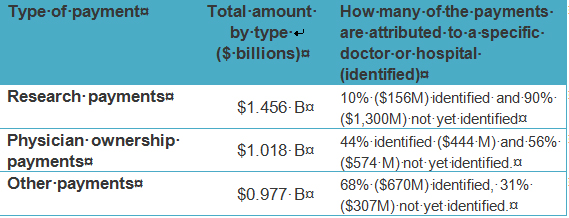Last week’s release of nationwide information about drug and device manufacturer payments to doctors was the beginning of a new era of sunshine and transparency. The information, which is made public under a provision of the Affordable Care Act, shows the millions of ways that drug and device manufacturers try to influence doctors, using gifts, free meals, free travel and other payments of some value.
How much is industry paying our doctors?
An initial look at the data by Pro-Publica showed that total payments made by industry to more than 546,000 physicians (including dentists, podiatrists, chiropractors, and optometrists) during the last five months of 2013 totaled more than $3.4 Billion.
Bringing sunshine and transparency to the previously murky and highly suspect financial dealings between drug and device makers and our nation’s doctors is a huge victory for consumers! It reveals how extensively industry interacts with our nation’s physicians.The fact that industry payments or gifts touched more than half of all U.S. doctors in just the last five months of 2013 raises serious concerns.
According to Pro-Publica, this transparency revealed that industry paid for more than 3.5 million free meals for doctors, and for more than 200,000 trips to nearly 80 different countries. Overall, industry spent nearly $93 million on free meals to doctors, and another $74 million on travel. The drug and device industry also spent more than $202 million hiring doctors to give promotional talks to help sell their products, and $158 million hiring doctors as consultants. An article in the NY Times last week found that a small number of doctors – about 130 based on the data available so far – each earned more than $100,000 for either consulting or public speaking.
All the data is not yet identified by name of physician or teaching hospital, however. In an abundance of caution, the Centers for Medicare and Medicaid Services (CMS) has withheld the names of physicians or teaching hospitals that received payments if CMS was unable to accurately match these payments to the correct physician. This problem was due to differences in existing databases that track doctors by their prescriber id numbers or state license numbers. In these cases, CMS has temporarily released this data without identifying the recipient. Altogether, payments without recipient identifiers account for 40 percent of the number of payments, but more than 60% of the total $3.4 billion. In terms of dollars, most of these funds are reportedly for research, which covers a broad range of activities, from giving medical or scientific advice on a product in development, to conducting actual studies or clinical trials.

Based on analysis by ProPublica.
Consumers and their doctors
The CMS website lets a viewer download the data, but it does not yet allow consumers to look up their own physicians. The agency has said that will be a future enhancement to the site, to make this information more accessible to the public. In the meantime, there are two other resources that consumers can use now to find out if their own doctor has received payments from the drug industry.
First, the website dollars-for-docs, hosted by the non-profit organization Pro-Pubica, allows consumers to look up doctors that have received payments from industry going back to 2010. While the recently released data from CMS is not included in the dollars-for-docs database yet, it is expected the site will do so soon.
In the meantime, TIME magazine has put the newly released data in an on-line search tool, where consumers can look up any doctor by name and town, and see what payments they received from August 1 to December 31, 2013.
For consumers, these disclosures can be empowering. Consumers have the right to know if their doctor is receiving money from a manufacturer of a drug that their doctor prescribes. However, this information can be confusing to patients, as well. Patients may assume that getting paid by a drug maker is a sign that their doctor is a valued expert, when in reality the payments are made to influence the physician. Alternatively, some patients may distrust their doctor for receiving any payments, even if the doctor is performing valuable medical research that contributes to a new drug, device or a new manner of medical care.
Many patients will start to question – correctly – whether these payments may have affected their care. But raising these questions with your doctor is a lot harder than it might sound. If your doctor has these interactions with industry, then asking them about accepting free meals, travel, consulting or other payments implies a question of whether the doctor is being influenced by these industry payments – a question that goes right to the doctor’s objectivity, professionalism, and personal integrity.
Unfortunately, most doctors think that they cannot be influenced by free meals, or other small gifts. But this is a myth. Research definitively shows that doctors are just like all of us — we generally feel a sense of obligation when we accept gifts from others, whether consciously or subconsciously. This effect has been shown to influence how doctors think about the drug companies that gave them the gifts, and about the drug or device products they promote.
This is an important example of the broader need for patients to be empowered to work with their doctors on a more equal level, but it’s going to take a lot of work to get there. Recent surveys show that a majority of patients don’t feel comfortable telling their doctors when they cannot afford the medicines they are prescribed. If these surveys reflect how comfortable patients are raising issues about prescribing decisions and drug choices in general, then serious work needs to be done to empower patients and consumers.
Advocates can help by raising concerns about how industry is paying doctors in their state or region, while also working to empower consumers to raise these issues individually with their doctors.
